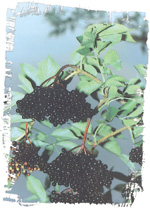Elderberries grow beyond the folklore into mainstream functional foods.

Elderberries have been employed in European folk medicine since antiquity for a plethora of maladies from arthritis and asthma to colds and constipation. In 400 B.C., Hippocrates referred to the elder tree as his “medicine chest.”
Today, elderberry is going beyond its classical medicine uses and is an increasingly popular functional food ingredient. The success of elderberry—especially in the Austrian, German and English markets—owes equally to its unrivalled flavor and extraordinary health benefits.
Elderberry Growth and Production
Austria is the world's primary elderberry-producing country. Formulators use Haschberg variety elderberries in juices, jams, fruit yogurts and wines. Demand is also increasing for elderberry extracts in the nutraceutical field. The epicenter of the booming Austrian elderberry industry is the Beerenfrost Co-op in Thalhammerstrasse, directed by Kurt Kaufmann. Kaufmann organized one thousand Austrian growers into an efficient co-op and built the immense Beerenfrost berry freezing facility.“In September at harvest, the elderberries must be cooled immediately, or they spoil. Here at Beerenfrost, elderberries are chilled to 20°C in less than 24 hours,” reports Kaufmann.
Potent Purple Pigments
At the heart of elderberry's rapidly increasing popularity lies a group of uniquely beneficial pigments. Analytical research conducted in Europe shows that elderberries are concentrated sources of anthocyanins, potent purple pigments that appear to benefit health in several ways. Ongoing research in Europe is is focusing on these anthocyanins.In the study, various bio-markers of stress, including glucose, magnesium and other plasma chemical levels, were analyzed.
Elderberry in the U.S.
Artemis International of Fort Wayne, Ind., is introducing food, beverage and supplement companies to the elderberry extracts and concentrates that originate from Beerenfrost and undergo further concentration at Iprona, a juice facility in Italy.Artemis president Jan Mills says that health findings have fueled significant interest in elderberry from the food and beverage sector, where companies use elderberry concentrate as a natural food coloring in place of FD&C dyes. “I get calls from companies that want to sell healthy products, especially if they taste good,” she notes. “It's a good thing for everybody.” NS
Chris Kilham is a health researcher, medicine hunter and the author of Tales From The Medicine Trail, published by Rodale Press. He can be e-mailed at: chris@medicinehunter.com
Looking for a reprint of this article?
From high-res PDFs to custom plaques, order your copy today!



